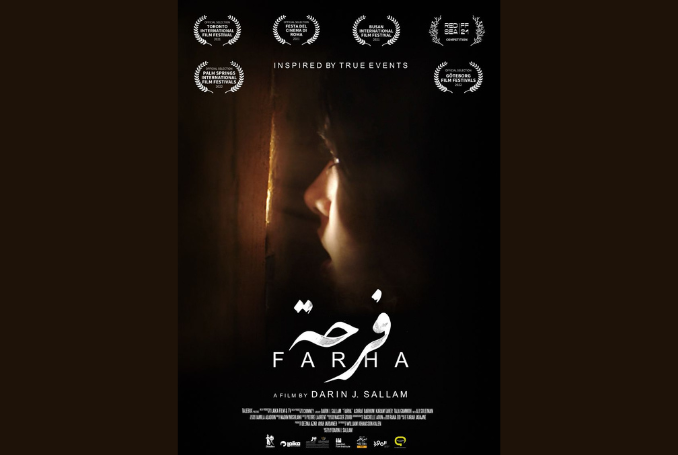Farha: The Nakba Through a Screen Door

By Jamil Khader
The controversy over Jordanian filmmaker Darin Sallam’s debut film, Farha (Arabic for joy), should not overshadow the artistic ways in which this film treats the traumatic horrors of the Palestinian Nakba. The complex aesthetic means that Sallam uses to represent the traumatic history of the Nakba will outlive the Israeli hasbara attacks for decades to come.
The film interweaves two levels of trauma, the collective national trauma of ethnic cleansing and the 14-year-old protagonist Farha’s own private (sexual) trauma. While the film is not able to register the sexual trauma directly in its diegetic world, it provides clues for the protagonist’s fear of sexual violation (rape) within the collective level of trauma.
The sexual crimes committed in the Nakba are shrouded in silence. Rosemary Sayigh notes, in her book Palestinians: From Peasant to Revolutionaries, the difficulty of collecting testimonies from the victims of the “sexual atrocities” that the Zionist paramilitary groups committed in the Nakba. The film attempts to fill in this gap but in complex artistic means. Although the sexual trauma remains repressed in the film, Sallam uses dense psychological motifs to represent it in its total horror. Sexual trauma is thus seen as horrific and shattering as, if not more than, the overt collective trauma.
The Israeli Backlash: Enjoying (Zionist) Founding Myths
It did not take long after the release of the film for Israeli officials and public to mount a vicious hasbara campaign to discredit the film as “false propaganda” anti-Israel film and to use bots and trolls to downvote its ratings on the IMDB site. They even accused Netflix of a conspiracy to destroy Israel!!
This campaign reflects the Israeli refusal to confront their Zionist founding myths and the violent origins of their state. Zionist discourses have perpetuated the lies that enable many Israelis to sustain the unbearable truth of the record of massacres and ethnic cleansing project that Zionist terrorist militias perpetrated in the Palestinian Nakba. Hence, they are determined to erase it, and any literary and cultural production that dares speak its name, from mainstream discourse.
It also reflects their insistence on mythologizing the Israeli army as the “most moral army in the world.” One Twitter account, now suspended, states: “In the film there are horrible sections [scenes] that show IDF soldiers as murderers, who commit crimes against innocent [civilians], something that never happened in the War of Independence.” Another accused the film of inciting anti-Semitic accusations of “blood libel.”
However, historians like Rosemary Sayigh and Ilan Pappe have documented the unspeakable massacres that the Zionist terrorist paramilitary groups committed against the Palestinians. Furthermore, in films like Alon Schwartz’s Tantura (2022), Zionist terrorists themselves admit to committing these atrocities and executing an unknown number of innocent and unarmed civilians. The facts do not matter anymore; all Zionist trolls and bots want to do is enjoy their fantasies.
The Nakba through a Screen Door
In this film, Sallam represents the collective national trauma in complex ways that are consistent with the insights of trauma theories. These theories suggest that trauma is unspeakable, because the core of a traumatic experience is repressed in the unconscious and cannot be represented coherently. Moreover, these theories propose that knowledge of trauma remains belated, incomplete, and fragmentary. This is the paradox of trauma: Trauma can be seen, as Cathy Caruth notes, but cannot be known.
The majority of the film’s running time (over 50 minutes) unfolds in the locked, dark pantry, in which the adolescent protagonist hides. This storage room is not just an expression, as Sallam reported, of her childhood claustrophobia. She stated that as a child she “had this fear of closed, dark places . . . So, when I grew up and became a filmmaker, I decided that this would be my debut feature.”
Rather, this dark storage room functions as the protagonist’s unconscious and re-enacts the way in which a traumatic event is registered in the unconscious. Unsurprisingly, the pantry sequence is the longest sequence in the film. In this space of the unconscious, Farha enacts her fantasy—her love for learning and pursuit of education. She spends some of her time reading a novel. In her descent into her unconscious, moreover, she confronts her aggression or death drive. In the pantry, she finds a revolver and bullets hidden in one of the grain sacks. This aggression is directed against one’s own self.
In the dark pantry, Farha is unable to confront directly the horror of the Nakba, in general, and the traumatic sequence of the massacre of the family, in particular. She remains in the dark in a literal and metaphorical sense, unable to integrate knowledge of the trauma into her consciousness.
In the diegetic world of the film, Farha can see glimpses of the massacre, but she cannot gain a full understanding of it. Sallam brilliantly uses the door of the pantry as a screen in its double psychoanalytic function: The door protects the protagonist from the trauma that is unfolding outside and at the same time, it enables her to access these traumatic events through a hole in the wall and slits in the door.
However, this knowledge remains incomplete and any understanding of this trauma is belatedly gained. There is no simple working through or straightforward processing of the trauma of the Nakba for the protagonist. As we see at the end of the film, Farha walks aimlessly on a dirt road like a “living dead,” just like the WWI veterans who, as Freud noted, were “possessed by some demonic power.”
Hidden Trauma, Screen Memory
This collective national trauma is not the only traumatic experience in the film. There is another level of trauma that is not registered in the diegetic world of the film namely, the protagonist’s unspeakable private trauma. However, the overt level of trauma includes a clue to the protagonist’s deeply repressed trauma.
In the family massacre scene, one of the soldiers disobeys an order to murder the infant. He tries to shoot it, but he does not. He tries to crush its skull, but he could not. He agonizes over the order and finally decides to throw a handkerchief over the infant’s head as it lays all alone outdoors in the cold night.
Farha witnesses all this through the slit in the door. Throughout the night, she listens to the baby’s cries until they could not be heard anymore. One would have expected Farha to save the baby and perhaps become his surrogate mother, a popular cultural motif, but she fails to save it. When she finally manages to shoot the door lock and open the door, she finds the baby already dead.
In the dark space of the pantry, the infant occupies a fantasmatic position in Farha’s unconscious fantasies and personal trauma. This scene epitomizes Farha’s fear of rape in the war and becoming a mother. The horror of this scene is also registered in the brilliant sound effects, which invoke recent international films in the horror genre that deal with alien invasions.
It is important to recall that the first part of the film revolves around Farha’s desire to pursue her education in the city as well as her sexual awakening. Her cousin is interested in her, asking her if she can really cook, and she questions her father about the reason her uncle and his son were talking to him. One of her best friends is also getting married and Farha attends her henna party.
Moreover, Farha gets her period in the pantry. In this context, the blood she smears her hand with acquires different symbolic meanings. In the realm of the unconscious, this blood could be related to an experience of sexual violation that she repressed deep in her unconscious. Alternatively, it could be related to, what Freud calls in his article on screen memories, “impressions and thoughts of a later date.”
In testimonies about the Deir Yasin massacre, as Sayigh shows in her book, “sexual atrocities” committed by Zionist paramilitary groups Irgun and Lehi took center stage in these testimonials. These terrorist militias sexually molested old women, raped and slaughtered schoolgirls, tore a girl in two, and in one case “cut open the womb of a nine months pregnant woman.”
Hence, Farha constructs “screen memories” to avoid confronting this trauma. The most important one is the momentary fantasy of prelapsarian Palestine she recreates early on in the film, in the scenes in which she is seen hanging out with her friends, picking figs, or showering in the stream. These mundane memories are offered as an escape from the sexual trauma she represses.
Like the women whose testimonies Sayigh collected, the film cannot directly narrate the unspeakable sexual horrors that the Zionists militias committed in the Nakba. Nevertheless, Sallam brilliantly employs screen memories to register another dimension of the trauma that must be confronted and to hold the perpetrators accountable for it.




Geen opmerkingen:
Een reactie posten